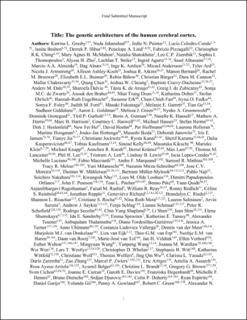The genetic architecture of the human cerebral cortex
Grasby, Katrina L.; Jahanshad, Neda; Painter, Jodie N; Colodro-Conde, Lucía; Bralten, Janita; Agartz, Ingrid; Alnæs, Dag; Gurholt, Tiril Pedersen; Kaufmann, Tobias; Sønderby, Ida Elken; van der Meer, Dennis; Westlye, Lars Tjelta; Wolfers, Thomas; Djurovic, Srdjan; Le Hellard, Stephanie; Andreassen, Ole Andreas; Jönsson, Erik Gunnar; Steen, Vidar Martin; Medland, Sarah E.
Journal article, Peer reviewed
Accepted version
Permanent lenke
https://hdl.handle.net/11250/2760637Utgivelsesdato
2020Metadata
Vis full innførselSamlinger
- Department of Clinical Science [2293]
- Registrations from Cristin [9487]
Sammendrag
INTRODUCTION
The cerebral cortex underlies our complex cognitive capabilities. Variations in human cortical surface area and thickness are associated with neurological, psychological, and behavioral traits and can be measured in vivo by magnetic resonance imaging (MRI). Studies in model organisms have identified genes that influence cortical structure, but little is known about common genetic variants that affect human cortical structure.
RATIONALE
To identify genetic variants associated with human cortical structure at both global and regional levels, we conducted a genome-wide association meta-analysis of brain MRI data from 51,665 individuals across 60 cohorts. We analyzed the surface area and average thickness of the whole cortex and 34 cortical regions with known functional specializations.
RESULTS
We identified 306 nominally genome-wide significant loci (P < 5 × 10−8) associated with cortical structure in a discovery sample of 33,992 participants of European ancestry. Of the 299 loci for which replication data were available, 241 loci influencing surface area and 14 influencing thickness remained significant after replication, with 199 loci passing multiple testing correction (P < 8.3 × 10−10; 187 influencing surface area and 12 influencing thickness).
Common genetic variants explained 34% (SE = 3%) of the variation in total surface area and 26% (SE = 2%) in average thickness; surface area and thickness showed a negative genetic correlation (rG = −0.32, SE = 0.05, P = 6.5 × 10−12), which suggests that genetic influences have opposing effects on surface area and thickness. Bioinformatic analyses showed that total surface area is influenced by genetic variants that alter gene regulatory activity in neural progenitor cells during fetal development. By contrast, average thickness is influenced by active regulatory elements in adult brain samples, which may reflect processes that occur after mid-fetal development, such as myelination, branching, or pruning. When considered together, these results support the radial unit hypothesis that different developmental mechanisms promote surface area expansion and increases in thickness.
To identify specific genetic influences on individual cortical regions, we controlled for global measures (total surface area or average thickness) in the regional analyses. After multiple testing correction, we identified 175 loci that influence regional surface area and 10 that influence regional thickness. Loci that affect regional surface area cluster near genes involved in the Wnt signaling pathway, which is known to influence areal identity.
We observed significant positive genetic correlations and evidence of bidirectional causation of total surface area with both general cognitive functioning and educational attainment. We found additional positive genetic correlations between total surface area and Parkinson’s disease but did not find evidence of causation. Negative genetic correlations were evident between total surface area and insomnia, attention deficit hyperactivity disorder, depressive symptoms, major depressive disorder, and neuroticism.
CONCLUSION
This large-scale collaborative work enhances our understanding of the genetic architecture of the human cerebral cortex and its regional patterning. The highly polygenic architecture of the cortex suggests that distinct genes are involved in the development of specific cortical areas. Moreover, we find evidence that brain structure is a key phenotype along the causal pathway that leads from genetic variation to differences in general cognitive function.
